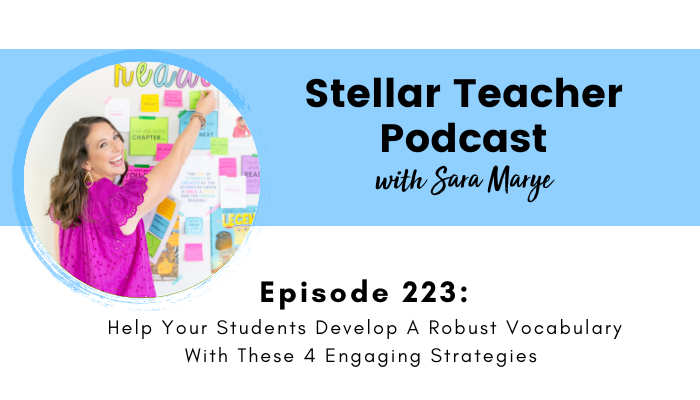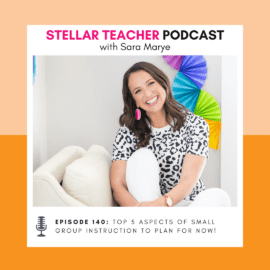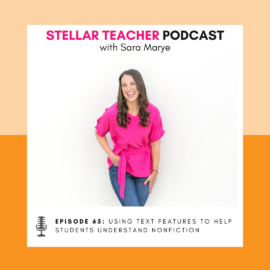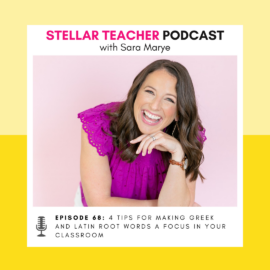
Click play below to hear 4 strategies you can use to help your students build a robust vocabulary.
Have you ever spent time teaching new vocabulary—defining words, providing examples, and guiding your students through practice—only to see them struggle to use those words in their own sentences? Frustrating, right? In this episode of the Stellar Teacher Podcast, we’re here to change that! We’re sharing four simple yet powerful strategies that will help your students not only grasp new words but actually use them in meaningful ways, building a robust vocabulary that sticks. If you want to supercharge your vocabulary instruction, this episode is a must-listen!
Why is building a robust vocabulary so crucial? Research shows that students need to understand 90-95% of the words in a text to truly comprehend it. Vocabulary mastery can account for up to 80% of reading comprehension scores! But teaching vocabulary is about more than just definitions—it’s about giving students repeated, meaningful practice using those words in context, creating a robust vocabulary that supports their reading comprehension and overall academic success.
In this episode, you’ll learn four actionable strategies designed to help your students build a more robust vocabulary, including “repeat after me,” yes/no questions, partner discussions, and sentence stems. These methods give students the support they need to use new words confidently and correctly. Tune in to discover how you can make vocabulary instruction more engaging and effective, ensuring your students don’t just learn new words—they truly understand and use them!
In this episode on helping your students build a robust vocabulary, I share:
- Why having a robust vocabulary is essential for your students.
- How vocabulary impacts reading comprehension.
- 4 strategies to help improve your vocabulary instruction and boost student engagement.
- How to get your students to use the words you teach them.
- Why you should challenge yourself to use one of these strategies today.
Resources:
- Join The Stellar Literacy Collective
- Sign up for my Private Podcast: Confident Writer Systems Series
- Sign up for my FREE Revision Made Easy email series
- If you’re enjoying this podcast, please leave a review on Apple Podcasts!
Related Episodes:
- Episode 204, 4 Ways to Enhance Your Vocabulary Instruction
- Episode 192, 5 Easy Steps for Effective Vocabulary Instruction
- Episode 182, What We Need to Understand About Reading Comprehension (And 8 Instructional Strategies)
- Episode 177, A Close Look at the 5 Pillars of Reading Instruction
Connect with me:
- Join my newsletter
- Shop my TPT store here
- Instagram: @thestellarteachercompany
- Facebook: The Stellar Teacher Company
More About Stellar Teacher Podcast:
Welcome to the Stellar Teacher Podcast! We believe teaching literacy is a skill. It takes a lot of time, practice, and effort to be good at it. This podcast will show you how to level up your literacy instruction and make a massive impact on your students, all while having a little fun!
Your host, Sara Marye, is a literacy specialist passionate about helping elementary teachers around the world pass on their love of reading to their students. She has over a decade of experience working as a classroom teacher and school administrator. Sara has made it her mission to create high-quality, no-fluff resources and lesson ideas that are both meaningful and engaging for young readers.
Each week, Sara and her guests will share their knowledge, tips, and tricks so that you can feel confident in your ability to transform your students into life-long readers.
Tune in on your favorite podcast platform: Apple, Google, Amazon, Spotify, Castbox, and more! If you’re loving this podcast, please rate, review, and follow!
Podcast (stellar-teacher-podcast): Play in new window | Download
You’re listening to episode number 223 of the Stellar Teacher Podcast.
We’re going to jump right into the content today. Now let me know if you can relate to this. You’re introducing a new vocabulary word, and you’ve gone through and you’re doing all of the things to explicitly teach it to your students. You are introducing the word, you are giving a student friendly definition. You’ve shown them a picture, you’re giving them some examples. You’re even using the word in context. And so now you want your students to practice using the word. So you ask them to use the word in a sentence. Except when you look at their sentences, you realize that based off of the context of their sentences, they don’t actually understand the meaning of the words, or it’s really unclear if they actually know how to use the words correctly. And I remember this when I was in the classroom, I would often ask my students to use new words in a sentence, and I remember seeing sentences that were similar to “I like consider.”, “I have invention.”, “We do motion in our class.”.
So if your students have done something similar, and you’re asking them to use words in a sentence, and when you review them, you are dissatisfied with the quality of the sentence or the detail, then this episode is really perfect for you. I’m going to share with you four strategies that you can use in your classroom that will help your students really get effective practice using new vocabulary words correctly. Because we do want our students to be able to use words correctly. We want them to be able to write sentences with new vocabulary words correctly, but in order to do so, we need to provide them a little bit of support. And that’s what these strategies are going to do. I think the best part about these four strategies is you literally can start using them today. So if you are listening to this on your way to work, first of all, I hope you have a wonderful day at school, but think about how you can incorporate one of these strategies into your classroom.
Now before we get into the strategies, let’s just quickly do a quick recap or review of why it is so important to help our students build a strong and robust vocabulary. If you’ve been a listener of the podcast for a while, you’ve heard me mention Scarborough’s reading rope a million times. Scarborough’s reading rope is a visual model that we can use to really help us understand what it takes to create skilled readers. Scarborough’s reading rope has two strands, the language comprehension strand and the word recognition strand, and they are woven together to create skilled readers. And one aspect of the language comprehension strand is vocabulary. In order for students to understand what they are reading, they have to have knowledge of the words. I’ve read so many different stats and statistics and quotes just about the importance of vocabulary instruction. A few things that have really jumped out to me is, first of all, understanding that adequate reading comprehension depends on a person already knowing between 90 to 95% of the words in a text. So that means our students have to have enough word knowledge to know the meaning of 90 to 95% of the words in a text. That’s very few words that they can miss.
Another thing that I think is important to recognize is that vocabulary can account for as much as 80% of students scores on reading comprehension assessments. So often we think of comprehension as this separate, isolated thing that we are teaching, but in reality, comprehension is incredibly dependent upon students’ vocabulary knowledge.
The other thing that I think it’s important for us to remember is that when we’re thinking about teaching our students word study, we’re teaching them syllable types, we’re teaching them prefixes and suffixes. Because we want them to be able to spell and read these big words that they’ve never, maybe seen before. But in order for students to be able to approximate a big word that they are decoding, it has to exist in their lexicon. And lexicon is just a fancy word for personal vocabulary. If students are looking at a word and they’re trying to figure out, let’s say, how to say the word franchise. If they’ve never heard the word franchise before, they might not know how to get to that word by breaking it down into the sounds or the syllables.
So we want to make sure that students have as big and robust of a vocabulary as possible. Again, if you’ve been listening to the podcast for a while, more than likely you are explicitly teaching vocabulary, so you’re well on your way, but we want to make sure that that explicit instruction you are providing them is actually sticking. We want our students to remember the words we teach. A really great way to do that is to give them some very practical yet scaffolded opportunities to practice using the words. So let’s talk about these four strategies that are really going to help improve your vocabulary instruction and boost student engagement.
So the first one is called repeat after me. This is a really great way to provide some scaffolded support to get your students using the word that you’re teaching them correctly and using it in the correct context. And this is a really easy thing that you can do after you’ve introduced the word to your students. So let’s say you taught your students the word motion. You’ve told them that the word motion means the action of being moved. So you’re going to share some sentences with them that use the word correctly, and then you’re simply going to ask them to repeat those sentences after you.
So it might sound something like this in your classroom: “I’m going to share sentences with the word motion in each of them, and then I want you to repeat each sentence to me exactly as you heard it. Okay? Here’s the first one. The motion of a swinging pendulum never stops unless something slows it down. The motion of a swinging pendulum never stops unless something slows it down. Okay, your turn to repeat it.” Then you’d have your students repeat it. You could even say it with them, and then you do the next one. “Have you noticed how the motion of a car changes when it goes uphill? Have you noticed how the motion of a car changes when it goes uphill?” And then you’d have your students repeat it, and then you would do the next one. “Without motion, airplanes wouldn’t be able to soar through the sky. Without motion, airplanes wouldn’t be able to soar through the sky.” Then you’d have your students repeat it. You could even have these written on the board, so that way your students don’t have to remember them. And you can guide them through using it. This is a great strategy to start with, because students can see how the word can be used in different sentence types. You can give them a question, you can give them a statement, an exclamation, you can show them how the word can be used in different places of the sentence, and you’re modeling how to use the word correctly with correct sentence structure when speaking. Super easy strategy really helps the students feel confident with their ability to use the word
The next one, and this one might be my favorite, is called yes or no. And let’s say you just taught your students the word dejected. So your students learned that this word means sad or depressed. So to help them, we really want them to understand the meaning of the word, you could ask them a series of yes or no questions that have to do with the word dejected. So you could ask them something like, Would you be dejected if you got an A on your spelling test? And more than likely, they would say no, right? I would not be sad or depressed to get an A on my spelling test. Would you be dejected if your family took you to Disney World? Again, the answer should be no, I would not be dejected. I would be very happy if I went to Disney World. Would you be dejected if you lost your pet? Yes, I would be very sad or depressed if I lost my pet. Would you be dejected if you broke your ankle? Yes, I’d be very sad or dejected if I broke my ankle. And when you’re having the students give their answers, you want to bring in either synonyms or antonyms. So if you’re saying, Would you be dejected if your family took you to Disney World?, you would say, No, I’d be really enthusiastic. So they understand that dejected is the opposite of enthusiastic. And with this strategy and with words like dejected, since this word is a very extreme emotion, you could also ask your students some questions that are a little bit in the gray area. It maybe wouldn’t be a clear yes or no. You can use that as an opportunity to talk about shades of meaning, the intensity of words. So you could ask your students, Would you be dejected if you got a B on your science test? And your students would probably say, Well, no, I wouldn’t be dejected. I maybe wouldn’t necessarily be thrilled, but I wouldn’t be devastated about it. You could ask your students, Would you be dejected if you missed the bus? And it’s like, okay, well, that would be a slight inconvenience. I might personally be happy about it, because I’d get to stay home from school. But ultimately the consequences would be greater, so I probably wouldn’t be dejected, but it would be a bummer. Would you be dejected if you missed the first five minutes of your favorite TV show? It’s like, okay, no, I wouldn’t be dejected about that. I might be a little bit frustrated, but I wouldn’t be extremely sad or depressed. So using different gray area scenarios can also help them really understand the intensity and when they should and should not use that word.
So the third strategy is to tell your partner. This strategy is great because it gives students an opportunity to really understand the context around when they should use the word or when they would use the word. So let’s say you taught your students the word hesitated, and your students know that it means to pause before doing something. So to help them understand the right context to use this word, you could ask them a series of open ended questionsand then have them discuss with a partner. So these are really scenario based questions. You could ask them something like: Share a time you hesitated before doing something. What was it that you were going to do and what did you do next? Or you could ask them, Why do people hesitate before trying new things? You could ask them, Have you ever hesitated before sharing an answer in class, why or why not? You could ask them, Think of a character who hesitated. Why did they do so? Again, these are all open ended questions, and I think they can really help students make some personal connections to the word and understand, the scenario and the situation in which it would make sense to use the word. And students might not necessarily be using the word in their responses, but you are prompting them to really think about the context in which we use this word, and the scenarios help them really understand the meaning of the word.
The fourth strategy is to give your students sentence stems. Again, the whole reason why we’re doing these strategies is because we want our students to be able to know how to use these words correctly. Ultimately, when a student learns a new word, we want them to be able to use that word in a sentence, but we want them to be successful doing so. To help set them up for success, we can give them either sentence stems, which is just the start of the sentence, or we could give them an entire sentence frame. So you’re basically giving them blanks to fill out. That way, we can guarantee that they’re using sentences correctly and that you’re avoiding sentences like: “I like consider.” or “I have invention.”. So let’s say you taught your students the word swapped. They know that it means to exchange or to give one thing for another. So you could give them sentence frames like: At lunch, I swapped my blank for blank. Or when we swapped blank, I felt blank. Or they swapped blank because blank. Sentence stems or sentence frames, really takes the pressure off of students having to think about syntax and sentence structure, and instead, they can really focus their mental energy on making sure that they are using the word correctly, and they’re adding details to the sentence that really connect to the meaning of the word.
Now these four strategies, are things that you can start using today, and maybe they sound super simple, but they have a really big impact. So a few things that I want you just to keep in mind or really consider. First of all, you can use more than one of these strategies with the words that you are teaching. In fact, you could use all four of them with the same word. You could use them on the same day. You could switch it up. But all of these strategies are going to help your students use words more correctly when they’re speaking and writing.
But these strategies are going to really benefit your ELL students as well. I know we have a lot of teachers that often say, How can I really support my ELL students? All of these strategies are going to help your ELL students because you are providing scaffolded support that is going to help them not only understand the meaning of the word, but also understand how to use it correctly. And one of the things that I like to really remind teachers of is that if a strategy is going to benefit a specific group of students, it’s going to benefit all students. So if it’s going to benefit your ELL students, guess what? It’s also going to benefit every other student in your class.
These strategies also really set your students up for success. When we think about our vocabulary instruction and when we ask students to use words. We want them to be successful. We want them to use words correctly. We don’t want them just to complete a portion of the assignment. And when we’re asking them to use a sentence stem or answer a yes or no question, we are ultimately setting them up to be successful in using these words. And I think when we do that, that is going to help our students feel more confident that they are using the word correctly. If students feel confident in their ability to use words correctly, they’re more likely to use them again in the future. So ultimately, when we are incorporating these strategies into our instruction, we are empowering our students to want to use these words again.
Let’s just quickly recap four really easy engagement strategies that you can use in your classroom to really help make your vocabulary instructions stick are: Repeat After Me – this is where you’re going to use the word in a sentence and then have your students repeat it, Yes or No – this is where you ask your students a yes or no question using the word to see if they can identify the correct context to use the word, Tell Your Partner – this is where you give your students questions or prompts to discuss the word with a classmate, and then Sentence Stems – this is where you’ll help your students out by giving them either a sentence stem or a sentence frame to use the word correctly.
Now I have a challenge for you, and that is to use one of these strategies today, because if you use a strategy today, you’re more likely to use it again the next day and the next day, and it will just become a part of your vocabulary routine. And of course, my team and I would love to know which one of these strategies you use and how it works with your students. We’d love to connect with you on Instagram @thestellarteachercompany, so let us know. Send us a DM, let us know if you found this episode helpful, and which specific strategy you used with your students today. I hope you have a stellar week, and I’ll see you back here next Monday.
Thanks so much for joining me today. If you enjoyed today’s episode and are finding value in this podcast, it would mean the world to me if you subscribe and leave a five star positive review, this helps me spread the word to more and more teachers, just like you. Don’t forget to join me over on Instagram @thestellarteachercompany, and you can also find links and resources from this episode in the show notes at stellarteacher.com.








Leave a Comment
You must be logged in to post a comment.